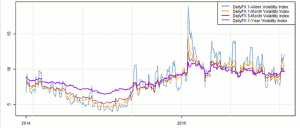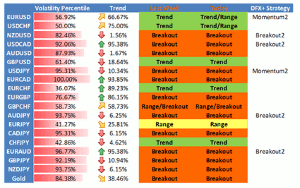Since forex volatility prices have surged following last week’s pronounced financial market turmoil and point to an important stretch for the USD and other major currencies, David Rodriguez, of DailyFX.com, uses technical analysis to address the next obvious question, "Which direction is more likely for the USD and broader counterparts?"
- Forex volatility prices point to a big start to the month of September across FX markets
- Our focus remains on our high volatility Breakout2 trading strategy
- We’ll keep a close eye on the DJ FXCM Dollar index as it breaks key resistance
The US dollar ends the month of August almost exactly where it began versus the euro and other key counterparts. What might we expect in the coming week and in September?
All eyes turn to key economic event risk for the US economy in what promises to be a big week across financial markets. Indeed, forex volatility prices have surged following last week’s pronounced financial market turmoil and point to an important stretch for the US dollar and other major currencies. The next question is obvious: which direction is more likely for the USD and broader counterparts?
As it stands, the Dow Jones FXCM Dollar Index has clawed back above key resistance and looks to resume its uptrend. Yet further gains are hardly guaranteed and it will be very important to watch how it starts the new month of trading.
History suggests that currencies are more likely to set highs and lows at the beginning and the end of a given period, e.g. highs/lows for September are more likely to occur in the first week than mid-month. Past performance is not necessarily indicative of future results, but we’ll watch how the dollar reacts to key data in what promises to be an exciting stretch across financial markets.
Derivatives markets are pricing in some fairly significant market moves in the coming week, further raising the likelihood of decisive price action.
Forex Volatility Prices Remain Elevated on Key Week for FX Markets

Data source: Bloomberg, DailyFX Calculations
Click
to Enlarge
Our data shows that the majority of FX traders tend to do poorly in times of elevated market volatility and current market conditions warn that it may be another challenging week for traders. We have observed that majority of traders tend to range trade, buy when prices are low and sell when prices are high. This works well during quiet market conditions, but such a technique is also likely to do poorly during fast-moving markets.
Traders should likely avoid range trading until we see some semblance of normalcy in currency trading markets. In the meantime, we’ll look to our volatility-friendly Breakout2 to outperform across key US dollar and Japanese yen pairs.
See the table below for full detail on market conditions and preferred trading strategies.
DailyFX Individual Currency Pair Conditions and Trading Strategy Bias
By David Rodriguez, Quantitative Strategist, DailyFX.com


















